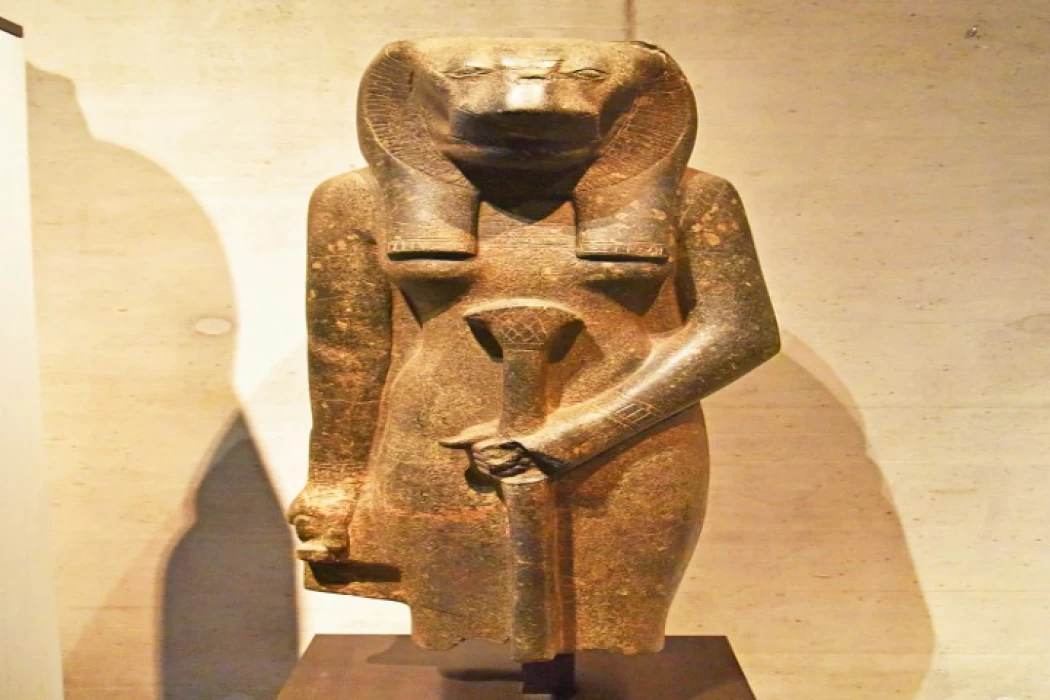
Goddess Sekhmet
Information About Goddess Sekhmet
Sekhmet means "she who is strong", and embodies the aggressive and offensive side, appearance and form of the mythological goddesses. Her body is female and her head is that of a female lion. She was the wife, companion and consort of a mythological figure called Ptah (Ptah in hieroglyphics), in addition to being the daughter of Ra, the mythological sun god.
The fact that Sekhmet appears twice in the Pyramid Texts indicates that she was expecting the king. The earliest ceremonial and funerary texts in Egyptian history are found in the Pyramid Texts. The goddess Sekhmet is considered the god of war, as she is the fiery power of the sun, and also the god of diseases and epidemics, and it was also believed that she cured diseases.
The "Theban Triad" gained prominence during the New Kingdom's reign (1550–1069 BC), which led to the formation of Sekhmet as an aggressive and violent embodiment of the mythological god "Mut." This explains why there are so many statues of Sekhmet in the funeral temple on the West Bank of Luxor and the Temple of Mut at Karnak that date back to Amenhotep III's period (1390–1352 BC).
There is a historical source that says that there are more than 730 statues of Sekhmet, and this is what led to a theory explaining that the reason for this huge number of statues of Sekhmet is the fear of the threat of the spread of epidemics, so the king made statues of the goddess Sekhmet to keep epidemics away from his community.
There is a theory that the number 730 statues of Sekhmet resembles the number of days in two consecutive years, so the king issued a decision to make a statue of Sekhmet every day for fear of epidemics. In a suggestion, it is said that the king himself was suffering from an illness and designed statues of Sekhmet so that he could approach her and be healed
According to ancient Egyptian religion, Sekhmet is the daughter of Amun Ra, the god of the sun disk and the most important of the gods of ancient Egypt. This deity is depicted with a woman's body, a lioness's head, and a sun disk on top. This goddess always wore a long red robe, symbolizing her roots.
Furthermore, because she was so powerful and feared, she held great importance for King Amenhotep III, who ordered the construction of 365 statues to worship her and thus calm her anger.
On the other hand, she possessed protective and healing powers, primarily to heal human fractures, making her the patron saint of physicians. Sekhmet was known as the goddess of love, arousing passions, being the most beautiful of the Egyptian gods, and always splendid.
Furthermore, Sekhmet was known as the eye of her father, Ra, the sun god. Seeing that humans were rebelling and would no longer pay homage to her, he decided to send his daughter to pursue and destroy them. She unleashed her great anger and began to attack those who had turned their backs on her father. Her unstoppable anger was so great and merciless that even the god Amun Ra felt humanity's mercy and, therefore, decided to stop her, but failed.
The goddess Sekhmet was called “the devourer” because she played a role in the myth of the destruction of humanity. This was one of the most important myths in the history of Egyptian civilization, which tells the story of the god Ra, as she was the daughter of Ra and the eye of Ra, who sent her to destroy his enemies.
She took the form of a female lion and destroyed these human enemies, However, she continued to destroy even the innocent later on, to the extent that the god Ra wanted her to stop, so he carried out a certain trick to prevent her from continuing to destroy all humans.
The name Sekhmet comes from the ancient Egyptian word s, m, which means “strength or power”. The ancient Egyptian name for Sekhmet translates to “(strong or mighty person).”
Moreover, the goddess was also given titles such as “(one) before the one who trembles evil” “Lady of Dread”. In addition, the titles “Lady of Slaughter” and “She Moles” also refer to Sekhmet.
She is the wife of the god "Ptah" in the "Menf" trinity (Ptah; Sekhmet; Nefertum). She is the goddess of oppression in ancient Egypt, the daughter of the god "Ra", and his eye that attacks hostile forces; She is one of the most important goddesses who embodies the eye of the sun god "Ra".














